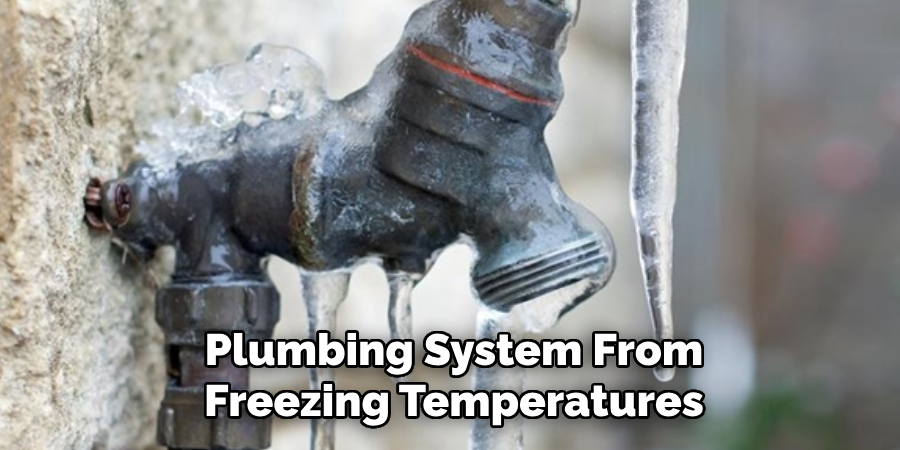During winter, freezing temperatures can pose a significant threat to sewer lines, leading to clogs, cracks, or even complete blockages. Frozen sewer lines can cause expensive repairs and major inconveniences for homeowners. Understanding how to prevent this issue is essential for maintaining a functional and efficient plumbing system during the colder months.

This guide on how to keep sewer lines from freezing provides practical tips and strategies to help you keep your sewer lines from freezing, ensuring uninterrupted water flow and reducing the risk of costly damages.
Benefits of Preventing Sewer Line Freezing
Preventing sewer lines from freezing comes with numerous benefits that safeguard both your home and your wallet. First and foremost, it helps avoid costly repairs that may arise from cracks, leaks, or blockages caused by frozen pipes. Secondly, uninterrupted water flow ensures daily household activities, such as cooking, cleaning, and bathing, continue without disruption, even during the coldest months.
Protecting sewer lines also minimizes the risk of sewage backups, which can lead to unsanitary conditions and potential health hazards. Additionally, implementing preventative measures can extend the lifespan of your plumbing system, reducing wear and tear over time. Overall, keeping sewer lines from freezing provides peace of mind while ensuring the functionality and safety of your home.
Needed Materials
Before getting started, you will need to gather some necessary materials to prevent sewer line freezing. These may include:
Insulation:
This can be in the form of foam pipe sleeves, heat tape, or other insulation materials. Insulation helps prevent heat loss and keeps the temperature of the pipes above freezing point.
Caulk or Sealant:
Caulk can be used to seal any gaps in your home’s exterior walls where cold air may enter and come into contact with your sewer lines. This will help maintain a warmer temperature around the pipes, reducing the risk of freezing.
Heat Source:
Having a heat source nearby, such as an outlet or space heater, can also help keep sewer lines from freezing. This is especially useful for exposed pipes that are more vulnerable to colder temperatures.
8 Simple Methods on How to Keep Sewer Lines From Freezing
Method 1: Insulate Exposed Pipes
One of the most effective ways to prevent your sewer lines from freezing is by insulating any exposed pipes. Pipes located in unheated areas such as basements, crawl spaces, or exterior walls are particularly vulnerable to cold temperatures. Use foam pipe sleeves or fiberglass insulation to wrap these pipes and maintain their temperature above the freezing point.

For additional protection, you can also apply heat tape to the pipes before wrapping them with insulation. Heat tape provides a consistent source of warmth, especially in extremely cold climates. Ensure the insulation fits securely and covers the entire length of the pipe to eliminate any gaps where cold air could penetrate. By insulating exposed pipes, you’ll reduce the risk of freezing and maintain the efficiency of your sewer system throughout winter.
Method 2: Keep a Steady Temperature in Your Home
Maintaining a consistent temperature within your home is another effective way to prevent sewer lines from freezing. By keeping your thermostat set to at least 55°F (13°C), you ensure that areas with plumbing, such as basements and crawl spaces, remain warm enough to avoid freezing. This is particularly important if you plan to be away from home for extended periods during the winter.
Avoid turning off the heat entirely or letting drastic temperature drops occur in your home, as this could expose pipes to freezing conditions. Additionally, opening cabinet doors under sinks can allow warm air to circulate around the pipes, further reducing the chance of freezing. Ensuring a steady indoor temperature creates a stable environment for your plumbing system and helps protect sewer lines from extreme cold.
Method 3: Seal Any Cracks or Openings in Your Home’s Exterior
Small cracks or openings in your home’s exterior walls can allow cold air to enter and come into contact with your sewer lines, increasing the risk of freezing. Inspect the exterior of your home for any cracks or gaps, particularly around areas where plumbing is located.
Use caulk or sealant to fill these openings and keep cold air out. This is especially important for older homes with inadequate insulation that may be more prone to heat loss.
Method 4: Remove Snow and Ice Build-up Near Sewer Lines
Accumulated snow and ice near sewer lines or septic tanks can cause temperatures around the pipes to drop, increasing the likelihood of freezing. Regularly clearing away snow and ice from these areas helps maintain a more stable temperature and prevents cold from penetrating down to the pipes.

Pay particular attention to any drainage areas or places where sewer lines are buried close to the surface, as they are more vulnerable to freezing. Use a shovel or snow blower to carefully remove snow and ice without damaging any components of your plumbing system. Additionally, creating proper drainage channels for melting snow can prevent water from pooling and refreezing around sewer lines. By actively managing snow and ice build-up, you can reduce the risk of damage and protect your sewer system during winter.
Method 5: Allow Faucets to Drip During Extreme Cold
Leaving faucets slightly open and allowing them to drip during extreme cold weather can help prevent sewer lines from freezing. This is because the constant flow of water keeps the pipes from reaching freezing temperatures, even if they are exposed to colder air.
While this method may result in slightly higher water bills, it can save you from costly repairs or damages caused by frozen pipes. Be sure to only leave a steady drip, as leaving faucets fully open can lead to significant water waste.
Method 6: Use Space Heaters or Heat Lamps for Exposed Pipes
In areas where insulation alone may not be enough, using a space heater or heat lamp can provide additional warmth for exposed pipes. This is especially useful for areas with poor insulation, such as basements or attics.
Be sure to follow safety precautions when using these heat sources and never leave them unattended.
Method 7: Install a Backup Generator
Power outages during extreme cold weather can put your sewer lines at risk of freezing if you rely on electric heating systems to keep them warm. To avoid this, consider installing a backup generator that can power essential appliances in the event of an outage. This will ensure that your home’s heating system remains functional and protects your plumbing system from freezing temperatures.

You can also consider investing in a backup heating source, such as a propane or kerosene heater, to use during power outages.
Method 8: Seek Professional Assistance
If you’re unsure about how to keep your sewer lines from freezing or if you suspect your pipes may already be frozen, it’s always best to seek professional assistance. A licensed plumber can assess your plumbing system and provide recommendations for preventing or fixing frozen pipes. They may also have access to specialized equipment, such as pipe thawing machines, that can help quickly resolve any issues with frozen sewer lines.
Following these methods on how to keep sewer lines from freezing can help protect your sewer lines from freezing and ensure the efficient functioning of your plumbing system during winter. By taking proactive measures, you can avoid costly repairs and potential damage to your home’s pipes. Stay warm and keep your sewer lines safe this winter with these tips.
Frequently Asked Questions
Q: How Do I Know if My Sewer Lines Are Frozen?
A: Signs of frozen sewer lines include slow or blocked drains, gurgling noises from pipes, and foul smells coming from drains. If you suspect your sewer lines may be frozen, it’s best to seek professional assistance.
Q: How Can I Thaw Frozen Sewer Lines?
A: It’s important to never use an open flame or electric heating appliance to thaw frozen sewer lines. Instead, seek professional assistance or use a specialized ppipe-thawingmachine. You can also try using hot water bottles or towels soaked in warm water to help gradually thaw the pipes.
Q: Are There Any Steps I Should Take Before Leaving My Home for An Extended Period During Winter?
A: If you plan on being away from home for an extended period during winter, it’s essential to take extra precautions to prevent your sewer lines from freezing. These include setting your thermostat no lower than 55°F (13°C), opening cabinet doors under sinks to allow warm air circulation, and shutting off the main water valve to prevent any potential leaks or bursts. It’s also a good idea to have someone check on your home periodically while you are away.
Q: How Often Should I Clear Snow and Ice Around Sewer Lines?
A: It’s best to regularly clear snow and ice around sewer lines, particularly after heavy snowfalls or freezing rain. Pay attention to areas where drainage may be blocked, as this can cause water to pool and refreeze around sewer lines.

Conclusion
Protecting your sewer lines from freezing is an important step in maintaining a functional and efficient plumbing system during the winter months. By applying the methods outlined in this guide on how to keep sewer lines from freezing, such as insulating pipes, managing snow and ice build-up, and using heating solutions, you can minimize the risk of costly damage and disruptions. Additionally, being proactive and staying vigilant about potential freezing issues can save you time, money, and stress.
Remember that professional assistance is always available if you’re uncertain or facing persistent problems. With these preventative measures and tips, you can ensure your home’s sewer system remains safe and operational throughout the cold season. Stay prepared, and enjoy a worry-free winter!
About the Author
Adrian Green is a passionate woodworking enthusiast who has dedicated his life to the craft of woodworking. From his early days working alongside his father in the family woodworking shop, Adrian has honed his skills and developed a deep love for creating beautiful, functional pieces with his hands. As the voice behind The Woodenify Blog, he shares his knowledge, tips, and inspiration with fellow woodworkers of all skill levels, helping them build confidence in their abilities while learning new techniques.
Professional Focus
- Specializes in DIY woodworking projects, from furniture making to home décor.
- Provides step-by-step guides, tips, and practical tutorials for woodworkers at any skill level.
- Focused on empowering readers with confidence and knowledge through easy-to-follow instructions and hands-on techniques.
- Passionate about building a community where makers can share, learn, and grow together in the world of woodworking.
Education History
University of Craft and Design – Bachelor of Fine Arts (BFA) in Woodworking and Furniture Design
Woodworking Apprenticeships – Gained extensive hands-on experience through various workshops and mentorships with seasoned craftsmen, refining carpentry and furniture-making skills.
Expertise
- DIY woodworking, carpentry, furniture making, and home décor projects.
- Creating clear, accessible tutorials and guides for beginner to advanced woodworkers.
- Helping readers experience the satisfaction and fulfillment of turning raw materials into stunning finished products.
